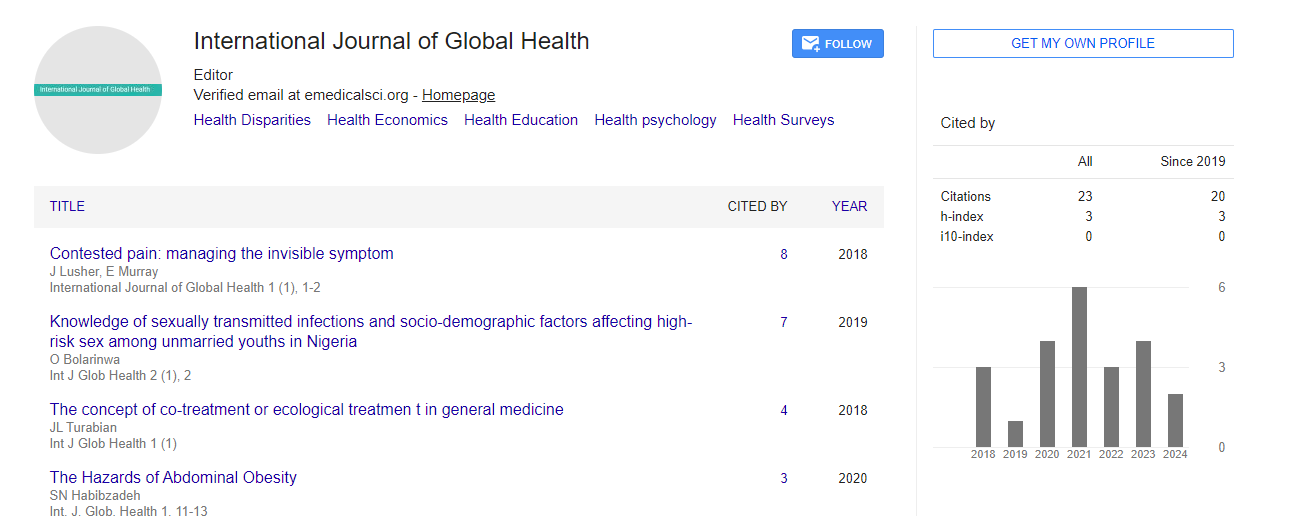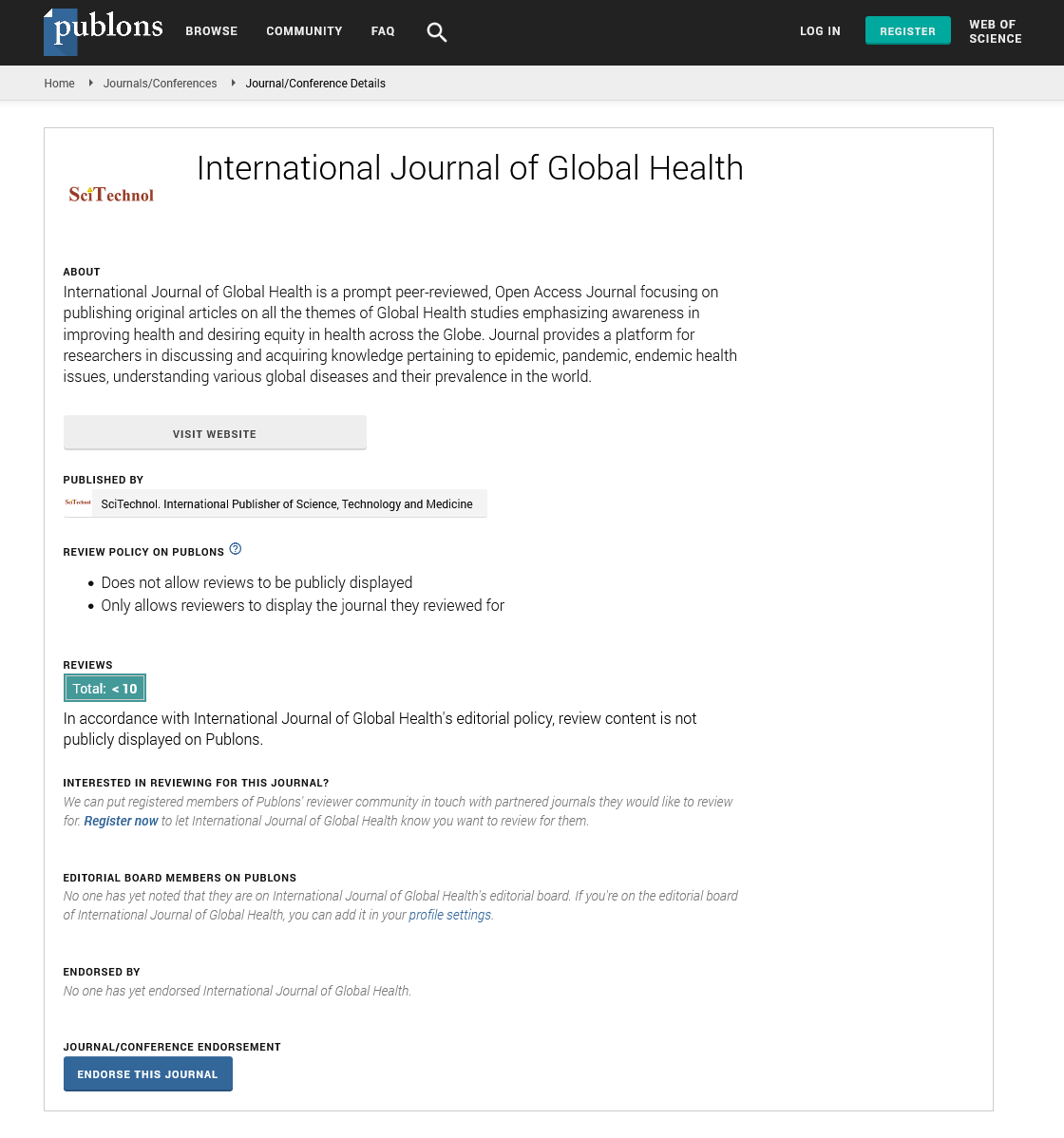Short Communication, Int J Glob Health Vol: 4 Issue: 4
A Short Communication on Urban Health
James Nickson*
Department of Urban Health and Health Care, Imam Abdulrahman Bin Faisal University, Dammam, Saudi Arabia
- *Corresponding Author:
- James Nickson
Department of Urban Health and Health Care, Imam Abdulrahman Bin Faisal University, Dammam, Saudi Arabia
E-mail: nicksonj320@gmail.com
Received Date: June 07, 2021; Accepted Date: June 14, 2021; Published Date: June 21, 2021
Citation: Nickson J (2021) A Short Communication on Urban Health. Int J Glob Health 4:3. 141.
Copyright: © All articles published in International Journal of Global Health are the property of SciTechnol, and is protected by copyright laws. Copyright © 2021, SciTechnol, All Rights Reserved.
Abstract
Urbanization is one of the main worldwide patterns of the 21st century that altogether affects wellbeing. More than 55% of the total populace live in metropolitan regions, an extent that is required to increment to 68% by 2050. As most future metropolitan development will happen in creating urban communities, the present reality has an interesting chance to direct urbanization and other major metropolitan improvement drifts in a manner that secures and advances wellbeing. That is additionally in light of the fact that the wellbeing and prosperity of their residents is maybe a city's most significant resource. However the vast majority of the 4.2 billion individuals living in urban communities – half of humankind – still experience the ill effects of lacking lodging and transport, helpless disinfection and waste administration, and air quality bombing WHO rules. Different types of contamination, like commotion, water and soil pollution, metropolitan warmth islands, and a deficiency of room for strolling, cycling and dynamic living likewise join to make urban communities focal points of the non-communicable illnesses pandemic and drivers of environmental change.
Keywords: Urbanization, environmental change, soil pollution
Urbanization is one of the main worldwide patterns of the 21st century that altogether affects wellbeing. More than 55% of the total populace live in metropolitan regions, an extent that is required to increment to 68% by 2050. As most future metropolitan development will happen in creating urban communities, the present reality has an interesting chance to direct urbanization and other major metropolitan improvement drifts in a manner that secures and advances wellbeing. That is additionally in light of the fact that the wellbeing and prosperity of their residents is maybe a city’s most significant resource. However the vast majority of the 4.2 billion individuals living in urban communities – half of humankind – still experience the ill effects of lacking lodging and transport, helpless disinfection and waste administration, and air quality bombing WHO rules. Different types of contamination, like commotion, water and soil pollution, metropolitan warmth islands, and a deficiency of room for strolling, cycling and dynamic living likewise join to make urban communities focal points of the non-communicable illnesses pandemic and drivers of environmental change.
Subsequently, the present urban areas and those of tomorrow are confronting a triple wellbeing trouble: irresistible sicknesses like HIV/AIDS, tuberculosis, pneumonia, dengue, and looseness of the bowels; non communicable infections like coronary illness, stroke, asthma and other respiratory ailments, malignancies, diabetes and despondency; and brutality and wounds, including street traffic wounds. While urban communities can bring numerous difficulties, they can likewise bring openings for better wellbeing, cleaner climate and environment activity. Solid metropolitan arrangements should coordinate with those difficulties since wellbeing is fundamental for cultivating great metropolitan vocations, assembling a useful labour force, making versatile and lively networks, empowering portability, advancing social association, and ensuring weak populaces.
Urban areas ought to likewise create utilization of the open door introduced by having a solitary authority under a city chairman who is engaged to take cross-sectorial choices, for instance on metropolitan arranging, transportation frameworks, buying, supply of energy, water and sterilization, and waste administration. Key metropolitan arranging will be the way to establishing steady and empowering conditions for wellbeing, ensuring that wellbeing and value contemplations are coordinated all through the arranging interaction, speculations, and strategy choices at the neighbourhood level.
Implementing the Urban Health Initiative
A city’s most significant resource is the strength of its residents. However 7 million unexpected losses yearly are ascribed to air contamination, most in creating urban communities with quick development. Intercessions to address air contamination in areas like vehicle, energy and waste may likewise bring extra medical advantages or accidental wellbeing hurts, which accentuates the significance for nearby partners, inside and past the wellbeing area, to have the devices and direction required for a thorough evaluation of arrangements and mediations. The WHO Urban Health Initiative (UHI) plans to lessen passing’s and sicknesses related with air and environment toxins, and upgrade wellbeing co-profits by strategies to handle metropolitan air contamination and brief environment poisons (SLCPs) – saving lives by connecting wellbeing, climate and manageable turn of events.
UHI assembles and engages the wellbeing area to utilize its powerful situation to advance the execution of air and environment toxin decrease procedures, gives apparatuses and direction to chiefs to survey potential medical advantages and wellbeing dangers, and exhibit to the public the full scope of wellbeing, financial and environment benefits that can be accomplished from carrying out nearby outflow decrease approaches and techniques. Urban areas are extraordinarily situated to neutralize air contamination, with activities that decrease air contamination’s wellbeing and monetary weight, while establishing a metropolitan climate that advances wellbeing and encourages dynamic networks.
References
- Acevedo GD. “Residential segregation and the epidemiology of infectious disease”. Soc Sci Med 51(2000): 1143-1161.
- Acevedo GD, Lochne KA, Osypuk TL, Subramanian SV. “Future directions in residential segregation and health research: a multilevel approach”. Am J Public Health 93(2003): 215-221.
- Acosta O, Toro PA. “Let's ask the homeless people themselves: a needs assessment based on a probability sample of adults”. Am J Community Psychol 28(2000): 343-66.
- Adler N, Newman K. “Socioeconomic disparities in health: pathways and policies. Inequality in education, income, and occupation exacerbates the gaps between the health “haves” and “have-nots.” Health Aff 21(2002): 60-76.
- Agnew R. “Foundation for a general strain theory of crime and delinquency.” Criminology 30(1992): 47-87.
 Spanish
Spanish  Chinese
Chinese  Russian
Russian  German
German  French
French  Japanese
Japanese  Portuguese
Portuguese  Hindi
Hindi 
